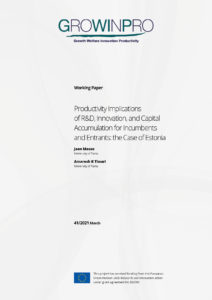In this paper, using Estonian Community Innovation Survey data, we study the role of R&D, capital accumulation, and innovation output on productivity for entrants and incumbents. We find that the impact of R&D investment on labour productivity is larger for the entrants compared to the incumbents. Entrants are found to be more productive and more heterogeneous in their total factor productivity (TFP) than the incumbents. Moreover, entrants who innovate are on average, in terms of TFP, 25% more productive than the entrants who do not, while the corresponding figure for the incumbents is 7%. In addition, it is mostly the incumbents who benefit from within-industry knowledge that is produced outside their own firm. Finally, for both entrants and incumbents, embodied technological change through capital accumulation is found to be more effective in generating productivity growth than R&D expenditure.
 Productivity Implications of R&D, Innovation, and Capital Accumulation for Incumbents and Entrants: the Case of Estonia
Productivity Implications of R&D, Innovation, and Capital Accumulation for Incumbents and Entrants: the Case of Estonia
Jaan Masso
Amaresh K Tiwari
working paper 7/2021
